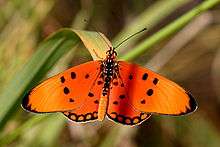Acraea acrita
Acraea acrita, the fiery acraea, is a butterfly of the family Nymphalidae. It is found in large parts of Africa.
| Acraea acrita | |
|---|---|
 | |
| Scientific classification | |
| Kingdom: | Animalia |
| Phylum: | Arthropoda |
| Class: | Insecta |
| Order: | Lepidoptera |
| Family: | Nymphalidae |
| Genus: | Acraea |
| Species: | A. acrita |
| Binomial name | |
| Acraea acrita Hewitson, 1865 | |
| Synonyms | |
| |
The wingspan is 45–55 mm. Adults are on wing year round, with a peak from February to June in southern Africa.[1]
The larvae feed on Passifloraceae, including Adenia species.
Subspecies
- Acraea acrita acrita (Uganda, southern Kenya, Tanzania, Democratic Republic of the Congo, Malawi, Mozambique, Zimbabwe, South Africa)
- Acraea acrita ambigua Trimen, 1891 (Zambia, southern Angola, Botswana, northern Namibia)
Taxonomy
Acraea acrita is the nominate member of the Acraea acrita species group. The clade members are:
- Acraea acrita
- Acraea chaeribula
- Acraea eltringhamiana
- Acraea guluensis
- Acraea lualabae
- Acraea manca
- Acraea pudorina
- Acraea utengulensis
gollark: Ī dō tōō.
gollark: Evil idea #368: make the Splash BSA take 5 days off eggs/hatchlings grabbed within a minute of using it.
gollark: 🌵 <:salt:325264288522436620>
gollark: Yūptoo.
gollark: With those changes and extra trophies dragon and trophy rarity would finally match!
References
- Woodhall, Steve (2005). Field Guide to Butterflies of South Africa. Cape Town, South Africa: Struik. ISBN 978-1-86872-724-7.
| Wikispecies has information related to Acraea acrita |
| Wikimedia Commons has media related to Acraea acrita. |
External links
This article is issued from Wikipedia. The text is licensed under Creative Commons - Attribution - Sharealike. Additional terms may apply for the media files.